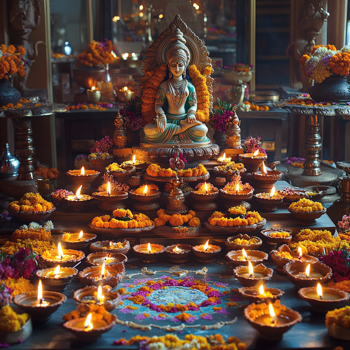- Victory of Good Over Evil: Diwali commemorates the return of Lord Rama to Ayodhya after his victory over the demon king Ravana, symbolizing the triumph of righteousness.
- Light Over Darkness: The festival is celebrated by lighting diyas and candles, signifying the eradication of ignorance and the emergence of knowledge and wisdom.
- Wealth and Prosperity: Goddess Lakshmi, the deity of wealth, is worshipped on Diwali, seeking her blessings for prosperity, success, and material well-being in the year ahead.
- New Beginnings: Diwali also marks the Hindu New Year in many regions of India, representing a time to start afresh with renewed energy and positive intentions.
- Strengthening Bonds: The festival is a time to connect with family, friends, and neighbors, fostering a sense of unity and togetherness.
- Spiritual Upliftment: Engaging in rituals and prayers during Diwali brings spiritual growth and a deeper connection with the divine.
- Mental and Emotional Well-being: The festive atmosphere, marked by light, color, and joy, enhances mental positivity and emotional resilience.
- Economic Prosperity: The invocation of Goddess Lakshmi during the Puja is believed to bring wealth and financial stability.
- Cleansing and Renewal: The tradition of cleaning and decorating homes symbolizes the removal of negativity, inviting positive energy and fresh beginnings.
- Cultural Connection: Participating in Diwali rituals fosters a sense of cultural identity and continuity, especially for younger generations.
Preparation
-
Clean the House:
- Thoroughly clean your home to remove any negative energies. This is a symbolic way of welcoming Goddess Lakshmi.
-
Decorate the Puja Area:
- Create a clean and sacred space for the puja. Decorate it with rangoli (colored powder designs), flowers, and oil lamps (diyas).
-
Set Up the Altar:
- Place idols or pictures of Goddess Lakshmi, Lord Ganesha, and other deities like Saraswati on a clean cloth.
- Arrange the items needed for the puja like kalash (water pot), incense sticks, diyas, flowers, sweets, fruits, rice, roli, kumkum, and some coins.
Performing the Puja
-
Invoke the Deities:
- Aachman: Sip water three times while chanting "Om Kesavaya Namah," "Om Narayanaya Namah," and "Om Madhavaya Namah."
- Pranayam: Perform a simple breathing exercise to calm the mind and focus.
-
Ganesh Puja:
- Begin by worshipping Lord Ganesha. Apply tilak and offer flowers, sweets, and fruits.
- Chant the Ganesh Mantra: "Om Gan Ganapataye Namah."
- Offer modaks or any sweet that Lord Ganesha likes.
-
Kalash Sthapana:
- Place the kalash filled with water and adorned with mango leaves and a coconut on top. This represents the presence of various deities.
- Apply tilak on the kalash, and offer rice, flowers, and a coin.
-
Lakshmi Puja:
- Dhyana: Meditate on Goddess Lakshmi to invite her presence.
- Apply tilak and offer flowers to the idol or image of Goddess Lakshmi.
- Chant the Lakshmi Mantra: "Om Shreem Hreem Shreem Maha Lakshmiyei Namah."
- Offer sweets, fruits, and coconut.
- Perform Lakshmi Aarti by singing the aarti song, waving the diya in a circular motion, and ringing the bell.
-
Saraswati Puja:
- Perform similar rituals for Goddess Saraswati, offering her white flowers and sweets.
- Chant the Saraswati Mantra: "Om Aim Saraswatyai Namah."
-
Kubera Puja:
- Worship Lord Kubera, the treasurer of the gods, by offering him a few coins, flowers, and rice.
-
Offer Naivedya:
- Offer a prepared plate of sweets, fruits, and other delicacies to the deities.
-
Light Diyas and Incense:
- Light the oil lamps (diyas) and place them around your home, especially in windows and entrances, to invite prosperity.
- Burn incense sticks to purify the atmosphere.
-
Perform Aarti:
- Perform aarti for all the deities using a ghee lamp, ringing a bell while singing devotional songs or the aarti.
-
Offer Prasad:
- Distribute the prasad (offering) among family members and guests as a blessing from the deities.
-
Prayers for Prosperity:
- Conclude the puja with prayers for prosperity, health, and happiness for all family members.
Post-Puja Rituals
-
Place the Diyas:
- Place the lit diyas around your house, at the entrance, and near windows to symbolize the victory of light over darkness.
-
Distribute Sweets:
- Share sweets and gifts with family members, neighbors, and friends.
-
Visit Temples:
- If possible, visit a nearby temple to offer prayers and seek blessings.
Special Notes
- Puja Timing: Perform the puja during the prescribed Muhurat (auspicious time) for Diwali, usually in the evening after sunset.
- Keep the Atmosphere Calm: Maintain a calm and peaceful environment during the puja.
- Dress Appropriately: Wear clean and preferably traditional clothes during the puja.
Following these steps with devotion and sincerity will ensure that your Diwali Puja is conducted properly, bringing blessings and prosperity into your home.




